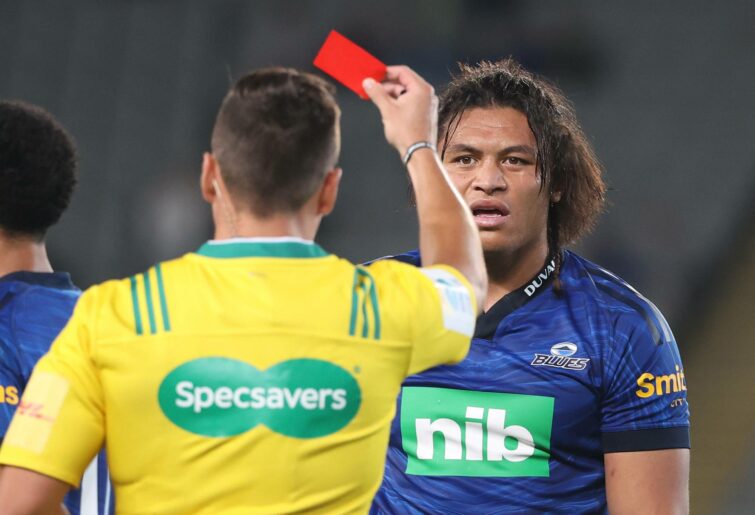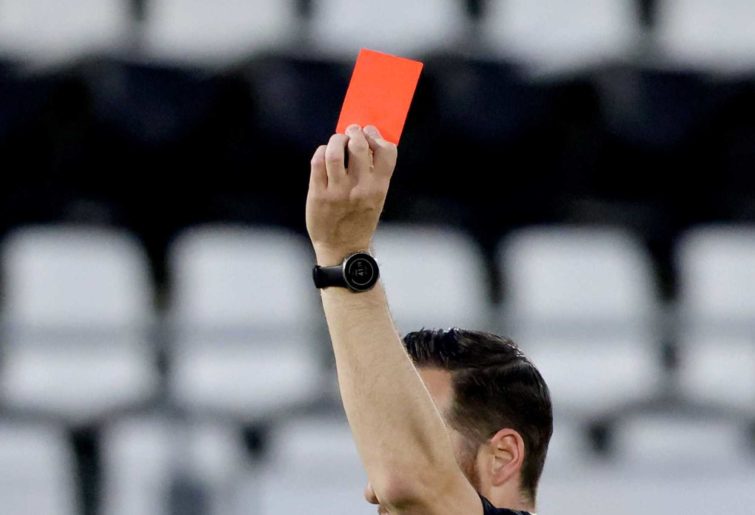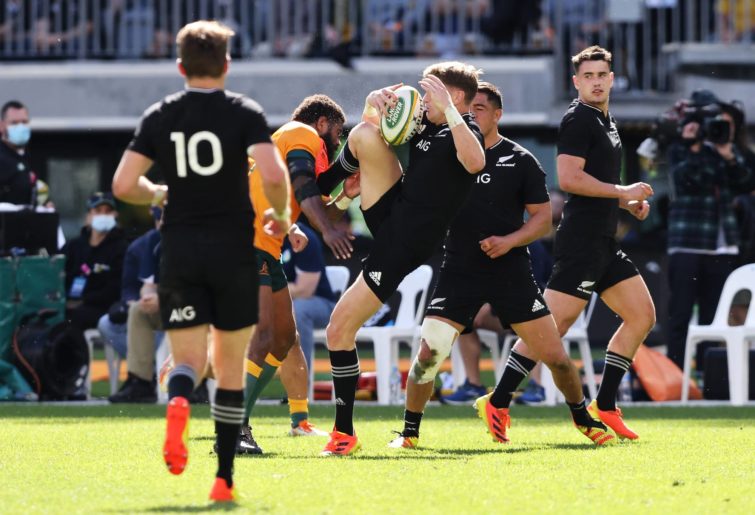Red cards are a bone of contention.
Whether it’s a clear-cut call, like the Sonny Bill Williams head-high shoulder charge on Anthony Watson in the second British and Irish Lions Test in Wellington in 2017, or one of the many that cause controversy and an endless amount of online debate, there is always disagreement.
It may not be over the incident, it might be the laws that are the focus, but discussion always follows.
One recent article made the claim that the “folly of the 20-minute red card is being brutally exposed in Super Rugby, where players have been sent off in six of the past seven matches”.
For the detractors, the trial seems at odds with the current concern around concussion. However, where is the evidence to show if the current laws are decreasing concussion? We must presume either they don’t yet exist, or the stats don’t support the anti-20-minute rhetoric.
The hypothesis that “Red cards do not ruin games. Dangerous play ruins games” is an interesting one considering the consistent complaining about inconsistent refereeing.
Look at the online comments after a weekend and read the sheer number of complaints from pundits and fans alike.
So is it really the 20-minute red card that should be under the microscope, or is it the refereeing? Perhaps we should be asking if all red cards are warranted? Or if each incident is of equal severity? Or even if a yellow card to one ref is a red card to another?
Not all red cards are equal in their gravity. Out of a total eight Super Rugby red cards for the season, I could argue that one was not a bonafide red (Reece Hodge’s red was for receiving two yellows), and two were unfortunate (Tom Banks and Caleb Clarke), leaving five genuine reds.

(Photo by Fiona Goodall/Getty Images)
In addition, the timing of two red cards didn’t allow the team to take advantage of the 20-minute replacement, and two of the teams that lost a player also lost the match. And it wasn’t a case of the team being in an “unassailable position” when the reds occurred.
When Tuaina Taii Tualima was red carded, the Reds were one point behind the Brumbies. When Shilo Klein was sent off, the Crusaders were only three points ahead of the Highlanders. And when Dane Zander was red carded the Reds were seven behind the Waratahs.
In 2021, the Wallabies managed to beat France 33-30 in Brisbane, after Marika Koroibete was red carded five minutes into the match for a high tackle that made contact with the head of Anthony Jelonch.
A few days later, the judicial committee rescinded the card stating, “No contact is made by the player (Koroibete) on the French player higher than the neck region”.
Should a player feigning injury have the power to get a player sent off? Or to win a match, or perhaps a series?
Surely this behaviour is as damaging to the sport as a mistimed tackle or an accidental collision.
It’s true that “Rugby is a team sport and if a player egregiously offends, their team should suffer.” But “Jelonch feigned a facial injury to con a ref, and the broader game, and no one said boo to him”.
The team that was victim to his play acting did suffer as a result of that red card, but it was due to the Oscar-worthy performance. How is that fair? How is that behaviour good for rugby? It certainly doesn’t correspond to the sport’s core values.
Paul Cully described Nemani Nagusa’s Round 7 red card as the anomaly over the weekend because the Drua were the only penalised team that lost, and observed that such stats are reinforcing the Northern Hemisphere belief that a 20-minute red “simply isn’t enough of a deterrent”.
But if red cards were really a deterrent, why were there two red cards given in rounds 12 and 13 of the United Rugby Championship after both Rounds 10 and 11 had a red card given as well?
If they were deterrents, wouldn’t it have stopped future infringing? If cards were deterrents, shouldn’t yellow cards also be deterrents?

(Photo by Soccrates/Getty Images)
After all, two yellows equal a red … but looking at the sheer number of yellow cards in the Top 14 (203 in 154 matches), this is obviously not the case.
So I am left wondering if red cards are really the deterrent being implied. Is it the card that’s the deterrent, or is it the ban, which also accompanies a 20-minute red?
Cully’s observation about the 20-minute red card “playing right into the hands of the Northern Hemisphere” is particularly interesting.
Reading the comments about the 20-minute red card on various rugby Facebook pages highlights the difference of opinion between the two hemispheres.
In general, those that support the 20-minute red card are from the Southern Hemisphere, and those against it are from the Northern Hemisphere.
The bias of many of the anti-20-minute brigade is obvious. The underlying message is the Southern Hemisphere isn’t concerned about player welfare or about acts of foul play. A tad simplistic, but the message is clear.
Or is it? According to an article earlier this year, “The RFU’s leadership would be prepared to support a radical change to red cards if trials in the southern hemisphere are deemed successful”.
I’m just not sure who determines whether the trial is successful or how success is rated.
Any radical change causes controversy, and to many, the law being trialled in Super Ruby Pacific (for the third year), which enables a red-carded player to be replaced after 20 minutes, is radical.
But even though the trial received “rave reviews” after being trialled in Super Rugby and the Rugby Championship in 2021, the law isn’t supported by everybody.
Nigel Owens isn’t a fan of the 20-minute red card. For Owens, it’s the message being given to players that’s the crux of the matter – if you know you’ll face 79 minutes with 14 players, you’ll be told not to infringe, but if it’s only 20 minutes, “then maybe you won’t be pressing that message home as much”.
And that is a real worry. Nobody wants to see players being coached to injure other players.
However, it’s not as if players aren’t already being coached to do things outside of what’s acceptable – slowing down the game and purposely going offside.
However, the trial law also has supporters. According to Ian Foster, the Jordie Barrett red card against the Wallablies in 2021 “was proof that the 20-minute red card law should be implemented globally”.
The incident, in the 28th minute of the third Bledisloe Test in Perth, saw Jordie Barrett being red carded when he inadvertently kicked Koroibete in the face while trying to balance himself after jumping to take a high ball.

(Photo by Paul Kane/Getty Images)
Both Foster and Rennie confirmed their support of the trial after that match, with Foster stating, “all the SANZAAR countries are pretty united in wanting to carry on this global trial”.
If the anti-20-minute red card opinions have one thing in common, it’s a lack of research. The statistics quoted recently have been cherry-picked to support an agenda. They are not presenting the full picture.
If a point is being made, where are the comparisons with other competitions? There’s been seven rounds of Super Rugby Pacific, 37 matches in total, so why only use the last seven matches?
It can’t be denied that the last round saw a bevy of red cards, but is that enough to stop the trial in its tracks?
According to NZR’s referee boss Bryce Lawrence, the number of red cards last weekend was a “one off”, with the 2022 stats being the same “if not lower” than last year.
Due to the lack of research provided in the anti-red-card articles, I decided to compare four global club competitions.
In the United Rugby Championship, there has been a total of 112 matches with 590 tries scored (5.26 tries/match). There have been 101 yellow cards (0.90/match) and nine red cards (0.08/match). In fact there were four yellow cards in one match, and five in another. Only 38 matches (34 per cent) had no card issued.
In Super Rugby Pacific, there have been 37 matches with 231 tries scored (6.24/match). There have been 34 yellow cards (0.91/match) and eight red cards (0.22/match). There were four yellows cards in one Round 4 match, and three in one Round 7 match. There were no cards given in eight matches (22 per cent). There is an average of 1.14 cards/match.
In the Top 14, there have been 154 matches, with a total of 688 tries scored (4.47/match). There have been 203 yellow cards (1.31/match) and 17 red cards (0.11/match). There have been three yellow cards given in 19 matches, four in two matches, and six in one match. In addition, there were two red cards given in one match. In 38 matches, no card was given (25% per cent). There is an average of 1.42 cards/match.
In Major League Rugby, there have been 52 matches, with a total of 336 tries scored (6.46/match). There have been 40 yellow cards (0.77/match) and three red cards (0.06/match). There were three yellow cards given in one Round 1 match and again in a Round 9 match. The average number of cards per match is 0.83.
From these comparative stats, Super Rugby certainly has a higher rate of red cards (0.22/match), but the Top 14 has a higher rate of yellow cards (1.31/match). It’s also worth noting that the Top 14 has a higher rate of total cards per match, with a card being given for every 1.42 matches.
But of course, without analysing every red card infringement, the question must be asked if a yellow in the Top 14 would be a red elsewhere, or if a red in Super Rugby would be a yellow elsewhere. These stats are interesting, but information on each infringement is needed to make the research complete.
There’s no doubt that the two hemispheres have different opinions towards the 20-minute red card. But surely there’s a middle ground that could be established.
Is an orange card (a new improved 20-minute red) the answer? This could be the happy medium between a yellow and red.
An orange card could be introduced for those instances where there’s no malice, where the tackle is due to mistiming or just a pure accident.
In those incidents, the offending player could be replaced after 20 minutes. Then the red card could be saved for those truly terrible acts of foul play – shoulder charges with direct contact to the head, punching, biting, and eye-gouging.
Or could rugby union adopt the same procedure of rugby league? In league, players aren’t usually sent off, instead they are placed on report and dealt with later by the NRL judiciary.
To me, option orange is the best way forward, as the match can continue as a fair contest between two teams and player welfare is still being addressed.
I’m in no way advocating for refs not penalising players as per the laws. In fact, I think the laws should be strictly applied.
But I also think there needs to be common sense applied as well. Player safety has to be the at the centre of any law changes. But player safety and providing a spectacle don’t need to be diametrically opposed.































































































